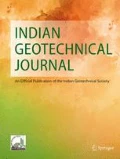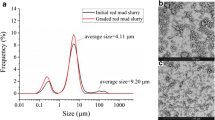Abstract
Red mud waste is generally transferred to the storage area in a slurry form with solids content varying from 15 to 40%. Due to arise of a variety of environmental and climatic conditions in the due course of time, settling behaviour of particles as well as properties of settled particles changes. Thus, understanding of the settling behaviour of waste particles becomes essential after disposing the waste into the pond. In addition, studies related to the settling behaviour of particles become important during the extraction of alumina from bauxite ore (i.e. in settlers). In the present study, efforts are made to investigate the settling behaviour of red mud waste particles when exposed to different aqueous environmental conditions. For testing purpose, a series of differential free swell tests were conducted considering aqueous environmental conditions such as tap water, distilled water, kerosene, NaCl solutions of 1.71 and 3.42 M, and HCl solutions with a pH range from 1 to 4, respectively. In addition, efforts are also devoted to characterizing the post-exposed sediment samples to ascertain possible changes in the mineralogical, morphological, and elemental compositions of the particles. Results reveal that aqueous environment has a considerable effect on the settling behaviour of particles, while the effect of pH found to be trivial. The analyses of characterization studies disclose a marginal to considerable changes in elemental, phase compositions and morphological characteristics of the post exposed particles.










Similar content being viewed by others
References
Sridharan A, Prakash K (2001) Settling behaviour and clay mineralogy. Soils Found 41(2):105–109
Li LY (1998) Properties of red mud tailings produced under varying process conditions. J Environ Eng 124(3):254–264
Tombácz E, Szekeres M (2006) Surface charge heterogeneity of kaolinite in aqueous suspension in comparison with montmorillonite. Appl Clay Sci 34:105–124
Kaya A, Oren AH, Yükselen Y (2006) Settling of kaolinite in different aqueous environment. Mar Georesour Geotechnol 24(3):203–218
Orban F, Pinter T, Sigmond G, Siklosi P, Solymar K, Toth P, Zambo J (1973) Processing of bauxites containing goethite. Hung Teljes 6:758
Villar LFS, Campos TMP, Azevedo RF, Zornberg JG (2009) Influence of laboratory techniques on the geotechnical characterization of mining and industrial wastes. In: 17th international conference on soil mechanics and geotechnical engineering, Alexandria, Egypt, pp 186–189
Deventer BBGV, Usher SP, Kumar A, Rudman M, Scales PJ (2011) Aggregate densification and batch settling. Chem Eng J 171:141–151
Parekh BK, Goldberger WM (1976) An assessment of technology for possible utilization of bayer process muds. USEPA-600/2-76-30.1:154
Li LY, Rutherford GK (1996) Effect of bauxite properties on the settling of red mud. Int J Miner Process 48:169–182
Newson T, Dyer T, Adam C, Sharp S (2006) Effect of structure on the geotechnical properties of bauxite residue. J Geotech Geoenviron Eng 132(2):143–151
Snars K, Gilkes RJ (2009) Evaluation of bauxite residues (red muds) of different origins for environmental applications. Appl Clay Sci 46:13–20
Davis CE (1973) The mineralogy of Jamaican bauxites. In: The Journal of Geological Society of Jamaica, proceedings of bauxite symposium, vol II, pp 6–20
Krizek RJ (2004) Slurries in geotechnical engineering. The Twelfth Spencer J. Buchanan Lecture, Texas A&M University, Texas, p 75
Ruyters S, Mertens J, Vassilieva E, Dehandschutter B, Poffijin A, Smolders E (2011) The red mud accident in Ajka (Hungary): plant toxicity and trace metal bioavailability in red mud contaminated soil. Environ Sci Technol 45(4):1616–1622
Gomes HI, Mayes WM, Rogerson M, Stewart DI, Burke IT (2016) Alkaline residues and the environment: a review of impacts, management practices and opportunities. J Clean Prod 112(4):3571–3582
Gräfe M, Power G, Klauber C (2011) Bauxite residue issues: III Alkalinity and associated chemistry. Hydrometallurgy 108(1–2):60–79
Rao BH, Reddy NG (2017) Zeta potential and particle size characteristics of red mud waste, chapter-8. In: Babu GLS et al (eds) Geoenvironmental practices and sustainability, developments in geotechnical engineering. Springer, Singapore, pp 69–89
Rout SK, Sahoo S, Das SK (2012) Utility of red mud as an embankment material. Int J Earth Sci Eng 5(6):1645–1651
Sundaram R, Gupta S (2010) Construction of foundation on red mud. 6th international congress on environmental geotechnics, New Delhi, India, pp 1172–1175
IS: 2720-Part 26 (1987) Indian standard methods of test for soils: determination of pH value. Bureau of Indian Standards, New Delhi, India
Liu Y, Naidu R, Ming H (2013) Surface electrochemical properties of red mud (bauxite residue): zeta potential and surface charge density. J Colloid Interface Sci 394:451–457
Kosmulski M (2002) The pH-dependent surface charging and the points of zero charge. J Colloid Interface Sci 253:77–87
Kosmulski M (2009) Compilation of PZC and IEP of sparingly soluble metal oxides and hydroxides from literature. Adv Colloid Interface Sci 152(1–2):14–25
Chevdov D, Ostap S, Le T (2001) Surface properties of red mud particles from potentiometric titration. Colloids Surf A 182(1–3):131–141
Zhang K, Ping H, Zhang L, Chen Q (2008) Surface charge properties of red mud particles generated from Chinese diaspore bauxite. Trans Nonferrous Met Soci China 18(5):1285–1289
IS: 2720-Part 40 (1977) Indian standard methods of test for soils: determination of free swell index of soils. Bureau of Indian Standards, New Delhi, India
Nikraz HR, Bodley AJ, Cooling DJ, Kong PYL, Soomro M (2007) Comparison of physical properties between treated and untreated bauxite residue mud. J Mater Civ Eng 19(1):2–9
Khaitan S, Dzombak D, Lowry GV (2009) Chemistry of the acid neutralization capacity of bauxite residue. Environ Eng Sci 26(5):873–881
Rai S, Wasewar KL, Lataye DH, Mukhopadhyay J, Yoo CK (2013) Feasibility of red mud neutralization with seawater using Taguchi’s methodology. Int J Environ Sci Technol 10(2):305–314
Reddy NG, Rao BH (2016) Evaluation of the compaction characteristics of untreated and treated red mud. ASCE GSP 272:23–32
Michaels AS, Bolger JC (1962) Settling rates and sediment volumes of flocculated kaolin suspensions. Ind Eng Chem Fundam 1:24–33
Das SK, Rout S, Alam S (2015) Characterization of red mud as a subgrade construction material. In: 3rd conference of transportation research group of India (3rd CTRG), Kolkata, India
Pecharsky V, Zavalij P (2009) Fundamentals of powder diffraction and structural characterization of materials, 2nd edn. Springer, New York
Wu F (2012) Aluminous goethite in the Bayer process and its impact on alumina recovery and settling. PhD dissertation, Curtin University
Soltani A, Estabragh AR (2015) Treatment of expansive soils with quality saline pore water by cyclic drying and wetting. Desert 20(1):73–82
Kim M, Kim S, Kim J, Kang S, Lee S (2013) Factors affecting flocculation performance of synthetic polymer for turbidity control. J Agric Chem Environ 2(1):16–21
Li LY (2001) A study of iron mineral transformation to reduce red mud tailings. Waste Manag 21(6):525–534
Ostap S (1984) Effect of bauxite mineralogy on its processing characteristics. In: Jacob L Jr (eds) Bauxite, proceedings of bauxite symposium. Los Angeles, CA, pp 651–671
Solymar K, Sajo I, Steiner J, Zoldi J (1992) Characteristics and separability of red mud. In: Proceedings of the 121st TMS annual meeting, San Diego, USA, pp 209–223
Cusack PB, Healy MG, Ryan PC, Burke IT, O’Donoghue LM, Ujaczki E, Ronan C (2018) Enhancement of bauxite residue as a low-cost adsorbent for phosphorus in aqueous solution, using seawater and gypsum treatments. J Clean Prod 179:217–224
Rai S, Wasewar KL, Lataye DH, Mishra RS, Puttewar SP, Chaddha MJ, Mahindiran P, Mukhopadhyay J (2012) Neutralization of red mud with pickling waste liquor using Taguchi’s design of experimental methodology. Waste Manag Res 30(9):922–930
Reddy NG, Rao BH (2018) Compaction and consolidation behaviour of untreated and treated waste of Indian red mud. Geotech Res. https://doi.org/10.1680/jgere.18.00005
Cengeloglu Y, Kir E, Ersoz M (2002) Removal of fluoride from aqueous solution by using red mud. Sep Purif Technol 28(1):81–86
Swain K, Mahamaya M, Alam S, Das SK (2018) Stabilization of dispersive soil using biopolymer. In: Singh D, Galaa A (eds) Contemporary issues in geoenvironmental engineering, GeoMEast 2017, sustainable civil infrastructures. Springer, Cham, pp 132–147
Rai S, Wasewar KL, Mukhopadhyay J, Yoo CK, Uslu H (2012) Neutralization and utilization of red mud for its better waste management. Arch Environ Sci 6:13–33
Ma P, Pierre AC (1997) Effect of interaction between clay particles and Fe3+ ions on colloidal properties of kaolinite suspensions. Clays Clay Miner 45(5):733–744
Acknowledgements
Authors are highly thankful to Science and Engineering Research Board (SERB)-Department of Science and Technology (DST), Government of India, for the financial support (Grant No.: SB/FTP/ETA-0297/2013) to carrying out this research work. The help is greatly acknowledged by the authors.
Author information
Authors and Affiliations
Corresponding author
Rights and permissions
About this article
Cite this article
Gangadhara Reddy, N., Hanumantha Rao, B. Characterization of Settled Particles of the Red Mud Waste Exposed to Different Aqueous Environmental Conditions. Indian Geotech J 48, 405–419 (2018). https://doi.org/10.1007/s40098-018-0300-z
Received:
Accepted:
Published:
Issue Date:
DOI: https://doi.org/10.1007/s40098-018-0300-z




